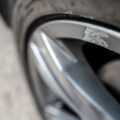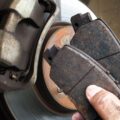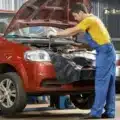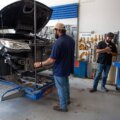How to Fix Paint Chips on Car
A small rock hits your hood and suddenly there’s a chip in your paint. It looks harmless at first, but give it time and it could turn into a rust spot. These tiny blemishes can ruin your car’s finish if you ignore them. The good news is you don’t always need a body shop. There’s a simple way to fix paint chips on car surfaces that saves time and prevents further damage.
Understanding Paint Chips on Cars
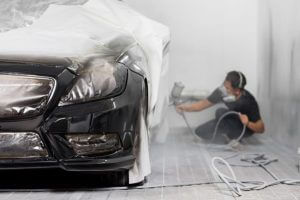
Paint chips are a common cosmetic issue. They usually happen when rocks or debris strike the car while driving. Over time, even small chips can expose the metal underneath. This can lead to rust and more serious damage if left untreated.
Drivers often think they need to visit a body shop right away. In many cases, you can handle minor chips on your own if you catch them early.
Why You Should Fix Paint Chips Immediately
Ignoring paint chips invites problems. Moisture can sneak through the clear coat and base paint. Once exposed, metal starts to corrode. That small nick becomes a larger patch of rust. It spreads beneath the surface and weakens your car’s structure.
Fixing a chip early keeps the damage isolated. You also protect your car’s resale value and keep it looking sharp.
What You Need Before You Begin
You don’t need professional tools to fix a basic paint chip. You can pick up most supplies at an auto parts store or online.
Supplies to Prepare
Automotive touch-up paint that matches your car’s color
Paint chip repair kit (often includes primer, paint, and clear coat)
Rubbing alcohol or wax remover
Fine-tip brush or toothpick
Microfiber cloth
Sandpaper (optional for larger chips)
Polishing compound
Make sure to look up your vehicle’s color code. It’s usually listed on a sticker inside the driver’s side door or in the owner’s manual.
Step-by-Step Process to Fix Paint Chips on Car
Step 1: Clean the Area
Wash the damaged area thoroughly using car-safe soap and water. Dry it with a microfiber towel. Then, wipe the chip with rubbing alcohol to remove wax or leftover debris. This helps the new paint bond properly.
Step 2: Evaluate the Damage
Check the depth of the chip. If you see metal or rust, the damage runs deeper. If it’s only through the clear coat, the repair will be easier. For rust, you may need to sand it down before you apply paint.
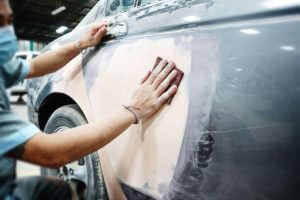
Step 3: Apply Primer (If Needed)
If the chip goes down to the metal, dab a small amount of primer on the exposed area. Use a fine brush or toothpick for accuracy. Let it dry completely before adding paint.
Step 4: Apply the Touch-Up Paint
Use the touch-up paint in light layers. Don’t flood the area. Dip your brush or toothpick into the paint and gently fill the chip. Let it dry between coats. You may need two or three layers depending on the depth.
Touch-up paint dries fast, but wait at least 20 to 30 minutes between coats.
Step 5: Add Clear Coat
Once the colour matches and dries fully, apply a clear coat to seal the repair. This layer protects the paint and adds gloss. Again, apply it with care. Let it dry for a full day if possible.
Step 6: Polish the Area
Once the clear coat hardens, use a polishing compound to blend the new paint with the old. This helps remove rough edges and gives a smooth finish. Rub it gently using a microfiber cloth.
Tips for Best Results
Avoid painting in direct sunlight. Choose a cool, dry day
Always test the color match first on an inconspicuous area
Store extra touch-up paint for future use
Use masking tape around the chip to keep paint inside the damaged area
Touching up paint is part science, part patience. Don’t rush it. Even if the first attempt doesn’t look perfect, you can repeat the process.
When DIY Won’t Cut It
Sometimes a chip is too deep or widespread for a quick touch-up. If rust has already spread or the panel has multiple chips, it may be better to call a professional. A shop can sand, prime, repaint, and refinish the area properly.
You should also consider professional help if:
The chip is on a curved body panel
The paint has already started peeling
Your vehicle has a pearl or metallic finish that’s hard to match
In these cases, a quick fix may stand out in a bad way. An auto body shop will have access to better tools and paint-matching technology.
Preventing Future Paint Chips
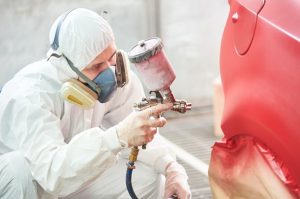
Fixing chips is helpful, but preventing them saves time and money. Here are a few ways to avoid new damage:
Use Paint Protection Film
Paint protection film is a transparent layer that guards against rocks, bugs, and debris. It’s ideal for bumpers, hoods, and mirrors. Many car owners invest in PPF right after buying a new vehicle.
Keep Your Distance
Driving too close to trucks or vehicles on gravel roads raises the risk of chips. Keep a safe distance and avoid roads with loose gravel when possible.
Avoid Automatic Car Washes
Some car washes use stiff brushes that can chip or scratch paint. Hand washing your car is safer and more gentle on the surface.
Final Thoughts
Fixing paint chips on your own takes patience and a steady hand, but it’s doable for many car owners. You can stop rust before it starts, save on repair bills, and keep your car looking great.
Take the time to assess the chip, get the right materials, and work carefully. If you’re ever unsure, or if the damage goes beyond touch-up work, reach out to a qualified auto body shop.
Need Professional Help in the Bronx?
Frank & Son Autobody offers paint chip repair, scratch removal, full resprays, and collision services. Our factory-trained technicians use OEM-grade materials and match your vehicle’s paint with precision.
We’ve been serving the Bronx since 1991. Whether it’s a minor scratch or a deep chip with rust, we can restore your paint and make it look like it never happened.
Contact us today to request a free estimate or stop by our shop to speak with our team.

